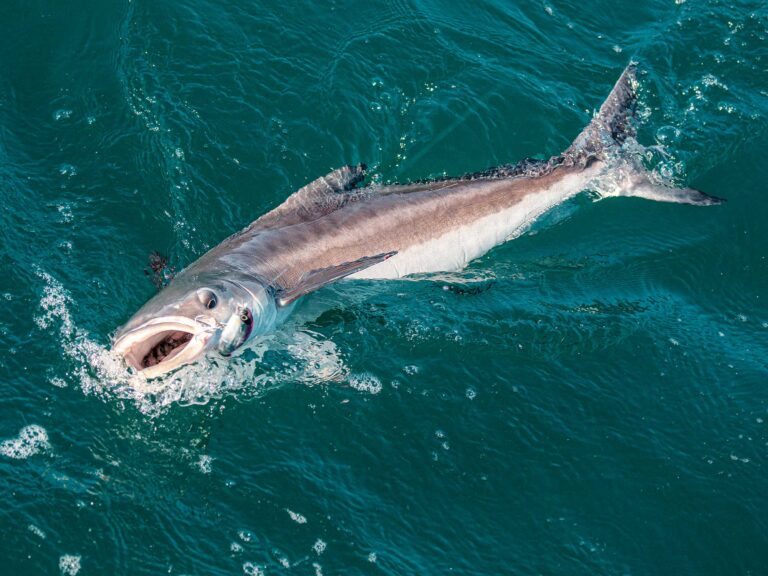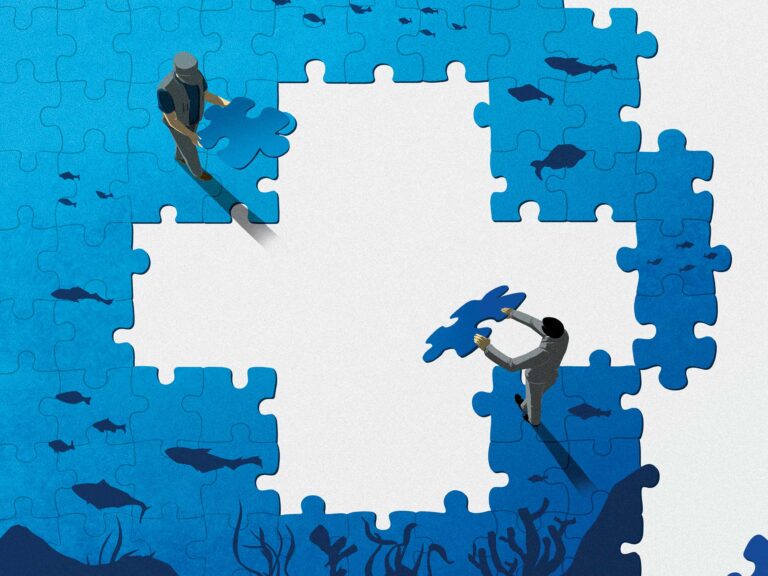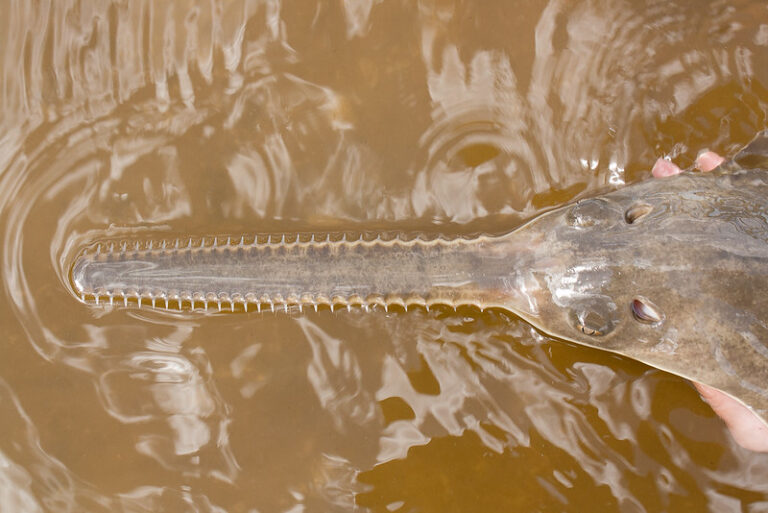
FEVER PITCH: After a long winter, nothing cures cabin fever like a cow striper on the end of the line.
Photo: Ric Burnley
Early spring is a tough time for anglers fishing along the Mid-Atlantic Coast: The water temperature hovers in the mid-40s, the air temperature rarely climbs out of the 50s, and wind and rain pelt anyone who ventures outside. Last spring was worse than usual. From March to May the weather and the fishing were poor. It seemed like every weekend foul conditions washed out my fishing plans. So when I happened upon a series of reports boasting of an epic run of huge stripers in the mid-Chesapeake, I jumped off the couch, picked up the phone and made arrangements to check it out.
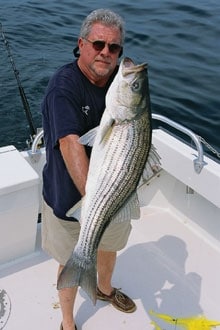
| |SPRING BREAK: When the weather cooperates, large striped bass are easy marks for Chesapeake trollers. Photo: Ric Burnley| Soon I was standing on a dock in Chesapeake Beach, on Maryland’s Western Shore, asking Captain Russ Mogul for permission to come aboard his 46-foot bay boat Mary Lou Too. Once the other anglers arrived, Mogul’s son and mate Chris threw off the lines and the boat powered away from the dock.
As we cleared the long inlet and turned into the open Bay, we were slammed by the near-constant northeast wind and muddy chop that had defined this early season. I braced for impact, but the massive bay boat plowed right through the mess. Meanwhile, Chris pulled out the gear and readied the rigs. Rod after rod emerged from the cabin and was placed into the holders until the boat was bristling with more than a dozen heavy-duty trolling outfits-each armed with some form of a tandem parachute rig. These rigs consist of two parachute jigs, which look like a punk-rock bucktail thanks to a five-ounce leadhead, bright hair sticking out in all directions and a 12-inch shad body. To build a tandem rig, Chris tied one of these jigs to 15 to 20 feet of 80-pound leader and attached another jig to 20 to 30 feet of leader material. Both leaders are joined to a 1/0 snap swivel that is connected to a two- to 20-ounce inline sinker. Then the sinker is snapped to the 50-pound Spectra running from one of the heavy-action boat rods. After all of the rods and baits were set, Chris busted out the planer boards-the Chesapeake’s answer to outriggers.
Planers allow skippers to troll multiple lines off each side of the boat. The contraption consists of two arm-length boards bolted parallel and attached to 150 feet of weed-whacker cord tied to a cleat on the gunwale. Once we reached the edge of the shipping channel that runs up the middle of the Bay, Russ slowed the boat to trolling speed (about two knots), and Chris dropped one of the planers in the water. The board acts like a floating shuttle and the force of the moving water pulls it away from the boat and stretches the cord.
|| |—| |Spring Striper Starters Shake off cabin fever with the Chesapeake’s best.Mary Lou Too Charters Captain Russ Mogul (301) 855-0784 www.maryloutoocharters.comSteppin’ Stone Charters Captain Dave Stone (410) 651-0121 www.dastone.com| Once deployed, Chris grabbed a rod rigged with a tandem parachute and dropped the bait back about 100 feet. Next, he doubled a rubber band over the fishing line and clipped it to a carabiner that is then snapped over the planer line and released to slide down the cord. Chris repeated the operation with two other lines, trolling three rods off each planer. The setup is designed so when a striper hits the bait, the rubber band snaps and the line swings free so the angler can fight the fish, similar to an outrigger. The carabiner slides down the cord.
Although some skippers troll as many as 25 lines, the Mary Lou Too limits its spread to 17 rods. Still, that’s more than 30 baits in the water, and strength is in numbers when imitating a huge school of fat-back menhaden that are swimming up the Bay in the spring. The diversity helps, too. With each rig sporting two parachute jigs, there is room for experimenting with different combinations of color and weight to find what is tickling the striper’s fancy on a particular day.
To cover the water column, they pull everything from unweighted rigs 180 to 200 feet back to 32-ounce Mojos that run in close and down deep. They even throw in a couple of umbrella rigs just for good measure.

RACKED AND READY: (left) As many as 25 rods are trolled at the same time in pursuit of stripers in the Bay. (center) Captain Russ Mogul, left, and his son Chris heave a linesider aboard. (right) Parachute jigs are a Chesapeake standard for fooling large bass.
Photo: Ric Burnley
While watching Chris manage this plate-spinning act, I noticed that dark-headed jigs were adorned with matching dark-colored shads.
“Using the same color attracts the fish better,” Russ explained. “They may like that color and can see it best.”
Chris had just finished setting out the last rod when a rubber band popped, and one of the planer board lines went down. He was quick on the rod, cranking in the slack and tightening up on a big fish. He handed the rod to one of the anglers, and the fight was on. Russ ran the boat fast enough to keep the lines tight while still letting the angler work on his fish. After a fantastic bout of give and take, a fat striper was rolling in the prop wash. Chris and Russ worked together to net the fish and haul it over the stern. It was a beautiful striped bass, measuring almost 40 inches.
Then the bite was really on. Every few minutes, another line went down and another striper would come over the stern. By noon we were back at the dock with fish in the box and a boatload of happy anglers.
Eastern Shore for Sure

| |

| |HAIR BALL: Stripers have no problem eating large jigs. (right) Planer boards keep lines from crossing and away from the boat. Photo: Ric Burnley| After fishing off chesapeake Beach I was infected with the spring striper bug. My next stop on the road to recovery from cabin fever was Crisfield, Maryland, on the Chesapeake’s Eastern Shore.
I found myself standing on a dock in the predawn darkness, this time asking Captain David Stone for permission to come aboard his 46-foot bay boat Rollin’ Stone. The immense craft was so new it still smelled of fresh paint and was so big we could have played full-court basketball in the cockpit-with room for cheerleaders. A few minutes after the crew of fishermen showed up, we threw off the lines and headed out into a cloud of early morning fog.
Soon, spring raised her ugly head again to spit salt spray and rain in our faces. But the Rollin’ Stone rolled smoothly across the slate-gray Chesapeake chop. Stone ran the boat through an obstacle course of crab-pot buoys while telling me a little about the mid-Bay’s rockfish run. The spring trophy season is open from April 15 to May 15 in Maryland waters and May 16 through June 15 in Virginia. Anglers can target stripers more than 28 inches long, but few of the fish that are caught come close to being that small. During this time, the boats troll umbrellas and parachutes up, down and across the deep water of the shipping channels. After mid-May, school-sized stripers arrive, skippers switch to chumming with bunker, and anglers switch to casting jigs and flies. This bounty goes on all summer and most of the fall until the big stripers show up again in the beginning of November. From then until the end of the year local skippers go back to trolling parachutes and umbrellas to capitalize on the fall run of trophy fish.
By the time we reached our destination, Buoy 72 on the western side of the channel, Stone’s mate, Rodney Pearson, and crew were already busy setting the spread. The Rollin’ Stone runs 18 lines, including three off each planer board. But instead of the parachutes preferred by Captain Mogul, Stone goes with umbrella rigs and bucktails. Each umbrella consists of eight, six-inch paddle-tail shad clipped on a wire frame around another shad that is armed with a 10/0 hook. Stone rarely changes his spread and each rod is keyed to a matching holder. The spread covers the water column with non-weighted lines to rigs pulled behind a 32-ounce inline sinker that fish deep.
Stone uses only white and chartreuse baits when he’s trolling for stripers. The starboard side of the boat is adorned in white umbrellas, and the port side sees only green.
“I’ve seen identical, back-to-back days, where green is hot one day and white is hot the next,” Stone says. “I don’t know why. I guess it’s just Mother Nature.”

| |
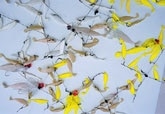
| |COW CATCHER: (top) This big striper fell to a trolled umbrella rig. (bottom) Umbrellas imitate swimming schools of baitfish. Photo: Ric Burnley| The crew hadn’t even finished putting out the baits when someone observed that one of the setups was low on line.
“That rod’s not low on line,” Pearson said. “It’s got a fish on it!” One of the first umbrellas to go in the water had found a fish, but the line-out alarm had not been fully engaged. The fish was swimming to China and no one had noticed.
The first angler up grabbed the rod and jammed the butt firmly into his gut. The line streamed, indicating that the striper was way back. The heavy bend in the rod and the line still jerking out of the reel meant that the fish was a big one. The angler grunted and moaned while working to crank in the big fish. Stone kept the boat out of the crab pots while Pearson kept the angler pulling on the fish. When the culprit surfaced behind the boat, we knew that all the effort had been worth it. Stone left the wheel to man the net and supervise the healthy release of the 40-inch striper. The day was looking brighter.
By the time that first fish hit the deck, the fog had lifted, the sun had come out, and the Bay had calmed considerably. We had a rare spring glimpse of the Chesapeake from Hollins Island to Smith Island to Bloodsworth Island.
After that, it was too easy. Stone trolled the Rollin’ Stone from one side of the shipping channel to the other, on an east-west pattern between two and three knots working from 60 feet of water to 90 feet and back again.
We trolled between Buoy 72A and Buoy 72, in, out and around crab-pot buoys all the while picking up one big striper after another. The sun was out, the seas were calm and I was cured of my cabin fever for good.
Mid-Bay SpreadS: Small-Boat Style
You don’t need a big boat to troll a winning striper spread.
Just because you don’t run a massive bay boat and own enough rods, reels and rigs to stock a small tackle shop doesn’t mean you can’t effectively troll for Maryland’s trophy stripers.
According to Lenny Rudow, author of Rudow’s Guide to Fishing the Chesapeake (Cornell Maritime Press; $15), the key to small-boat success is: “Umbrellas, umbrellas, umbrellas.” To maximize the number of baits and minimize the amount of tackle, Rudow uses umbrella rigs with eight teasers and a stinger. Run at least four unweighted umbrellas staggered from 100 to 150 feet back from the gunwales and transom. Then, throw in a couple of five- to eight-ounce tandem parachute rigs 100 to 150 feet behind the gunwale or T-top rocket launcher. Some crews prefer to add big Mann’s Stretch plugs down the middle. Rudow recommends that these go, “Way the hell back, dump half of the spool.” Many anglers build their own planer boards and use them to pull a couple more tandem parachutes 100 to 180 feet back off each side of the boat. All together that comes to 45 baits in the water-enough to ring the dinner bell for a passing trophy striper.
For more how-to, where-to and when-to on fishing the Chesapeake, pick up Rudow’s Guide to Fishing the Chesapeake at any major book store or online from Cornell Maritime Press, www.cornellmaritimepress.com-R.B.





